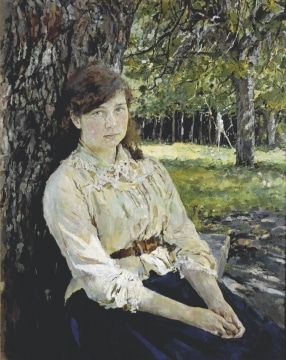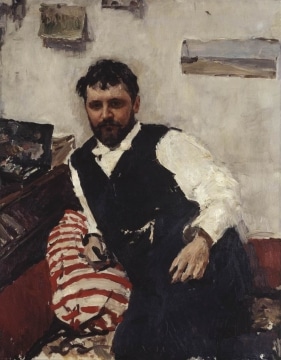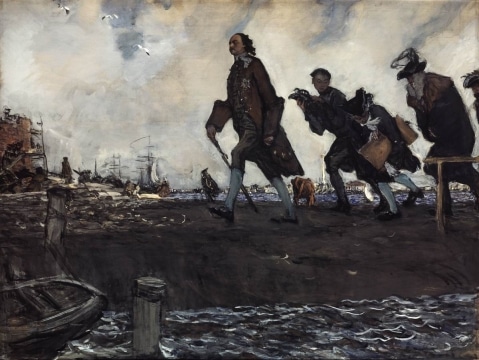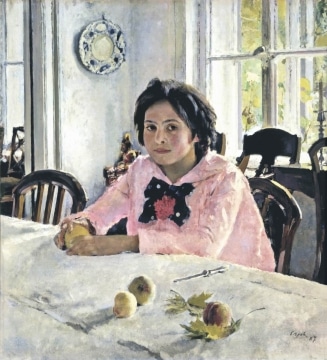Valentin Aleksandrovich Serov, born January 7, 1865 (old style, January 19 new style) in St. Petersburg, is best known as one of the premiere portrait artists of his time. Working between the nineteenth and twentieth centuries, his work represents a drifting away from realism and toward the Impressionist movement in Russian art. The works for which he is best known show a strong Impressionist influence.
Serov was born to an artistic family. His father was A.N. Serov, an opera composer, and his mother was Valentina Bergman, also a composer and a musician. Though he didn’t follow in his family’s musical footsteps, his talents as an artist did not go unnoticed, even at a very young age. After the death of her husband, Serov’s mother took the boy to Paris to encourage and facilitate his artistic training in painting. In Paris, he tutored under the famed Ilya Repin, and Repin’s influence is very visible particularly in Serov’s early work. Repin advised his student to study at the Academy of Fine Arts in Petersburg, where Serov received much of his formative education. Although the Serov family was struggling financially, they were aided by a wealthy entrepreneur and patron of the arts, Savva Mamontov. Mamontov allowed the Serovs to live with him at his estate while Valentin remained a student.

At the Academy, Serov studied for five years from 1880 to 1885 but left school before graduating. As a student and in his early career, he dabbled in graphic artistry, stage designing, and book illustrations. His portrait work, however, is what he remains best known for. Perhaps his most recognizable work is his 1887 “Girl with Peaches.” This is a portrait of Vera Mamontova, the eldest daughter of Savva, who had opened his home to Valentin and his mother. The 91 in x in 85 oil on canvas painting is now in the State Tretyakov Gallery in Moscow. Vera is seated at a dining table at the Mamontov estate, Abramstsevo. The Abramstsevo estate was an important figure in the late 1880s, as it was also the site of a burgeoning colony of artists especially interested in ridding Western influence from Russian art.
The portrait of Mamontova, according to the Tretyakov Gallery description that accompanies it, provided the “roadmap” for the development of Russian Impressionism. The piece is a mix of cool, white, and grey tones broken up by the bright figure of the young girl at the composition’s center. Her dress is a pastel pink, the bow across her chest a smattering of black but broken up by a flower placed in the bow’s middle, and her dark hair is in harmony with piece’s the dark, wooden accents. The natural light captured as it comes in the window matches the subdued orange color of the fruit she holds in her hand. Serov masterfully captured the girl’s expression and body language, depicting an impatient but tolerant youth, sitting for a portrait while the world outside awaits her. “The artist achieves here a balance between the girl’s state of mind and the world around her,” reads the Tretyakov description of this piece.
Even in 1888’s “Sunlit Girl, Portrait of M.Y. Simonovich,” Serov’s colors are shady and subdued, while the most luminous parts of the painting are on the subject’s face. “Thus is produced the image of interpenetration of sunlight and of the light of the human soul,” reads the Tretyakov description. The subject’s belt, her hair, and a row of trees behind her unify this composition in dark tones, made light again by her warm face and light eyes. These early works are representative of Serov’s preferred color scheme. While he includes color, his chosen shades were usually soft pastels and not like the rich, bright hues that were characteristic before his emergence around the mid-1880s.

After these early paintings helped establish him as an artist, Serov joined the Peredvizhniki. While a part of that group he was commissioned to paint portraits of many important figures. The dark brown and black tones of even the light “Girl with Peaches” are seen again in works like the 1897 commissioned portrait of Grand Duke Pavel Aleksandrovich, also on display at the Tretyakov Museum. His landscapes were likewise dimly lit and colored with subdued earthy shades, including 1985’s “October, Domotkanovo.” His color use is often strategic, as seen in 1891’s “Portrait of K. A. Korovin.” In this portrait of his painter friend, Serov uses earthy, dark colors in every part of the painting, except for the red and white striped pillow where Korovin rests his right arm. The color here was meant highlight Korovin as an artist and the brush in his right hand.
Another distinctive work is his 1907 “Peter I,” which depicts the Russian tsar in brooding colors. The piece depicts Peter as an architect and an automaton. Viewers see Peter from the perspective of from the ground up, “emphasizing the grandeur of the emperor’s rushing figure,” reads the accompanying Tretyakov description. Serov said of Peter “…He walked in enormous strides, with all his retinue having to follow him at a run. I can imagine what a monster that man was in the eyes of foreigners, what a terror he was to the people of St. Petersburg at the time.” Serov captures this sentiment clearly, as Peter is shown upright and tall, his followers hunched over and scurrying to keep up with the towering, hasty tsar.

In the early 1900’s, Serov broke with the Peredvizhniki and became more closely associated with the Russian art magazine and group “Mir iskusstva,” or “World of Art” art nouveau movement. This group was dissatisfied with what they saw as low artistic standards set forth by the Peredvizhniki, and wanted to hold up principles of the emerging Art Nouveau. This movement sought a departure from so-called “academic” art and ushered in a taste for structures and lines inspired by natural forms – flowers, plants, curvature in nature. The influence of this movement is seen perhaps most clearly in works like his 1910 “The Rape of Europa,” which marks
a very different turn for Serov’s works. Figures in this work are much flatter, his paintbrush stroke much broader, and the curves found in the waves of the ocean to the horns of the bull are exaggerated.
Before his death in Moscow in 1911, Serov also experimented with sculpture, re-creating his earlier painting “The Rape of Europa” painting in bronze.
Serov is known for his skills in portraiture and his eye for color. However, perhaps even more important was his his willingness to depart from the techniques that made him famous and his eagerness to try new methods. These helped cement him as one of the Russian masters.







